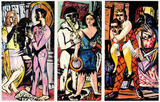Max Beckmann: Double-Portrait. Max Beckmann and Quappi, painting (1941)
Max Beckmann: Double-Portrait. Max Beckmann and Quappi, painting (1941)
When we examine the artist Max Beckmann and his exile, we must not forget his wife , Mathilde “Quappi” Beckmann (nee Kaulbach), who went into exile with him. She was at his side as he was defamed as “degenerate” and was dismissed from the vocational school for arts and crafts in Frankfurt in 1933. She emigrated with him in 1937 and lived through the subsequent difficult years of war and German occupation. Naturally, she also accompanied him on the later stations of his exile in America.
In 1925, the year that Max Beckmann married his second wife who was 20 years his junior, he painted the “Carnival Double Portrait”. There are plenty of individual self-portraits and portraits of his wife, but it was not until 1941 that he produced another double portrait. It was to be the last one he painted. In the picture, we see Max and Quappi, who are clearly going out, they are standing close together, but not side-by-side. There is nothing in the painting that points to Amsterdam – where they were living at the time. The painter is walking ahead of his wife and takes up the largest proportion of the picture, whereas his wife is slightly in the background, partially hidden by her husband. Erhard Göpel recorded that when they walked through the city, he would often let his wife walk some meters ahead so he could be alone. This distance, despite their closeness, can also be seen in the picture.
The dark figure of the painter in his brown suit contrasts heavily with his bright yellow background, his wife, on the other hand, blends more into her dark background. Beckmann has his hand with his walking stick clamped energetically by his side, and his darkly-lidded eyes in his heavily modelled head look equal energetically at the viewer, to whom he is presenting his hat from London. Although the young woman has a bouquet of flowers in her right hand, her left hand, which rests on the shoulder of her husband, has an uncertain appearance which is emphasised by her sideways glance.
Although the painter's diary contains the verse “Ach wie schön ist es allein zu seien / Besser ist es aber doch zu zweien!” [“How lovely it is to be on one's own / But spending time together is even better”] (3 September 1945), it is impossible to ignore other entries, such as “being alone is the best thing in life” on 30 July 1943 or on 11 August 1945 when he writes “One lives only for individuals in the past[!] and future [!] … and the most correct way is just with oneself.” [Quotes: ed. trans.]
The painting in the only one that was sold officially during Beckmann's exile in Amsterdam.
Christian Lenz, Max Beckmann Archiv



